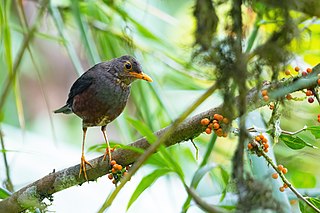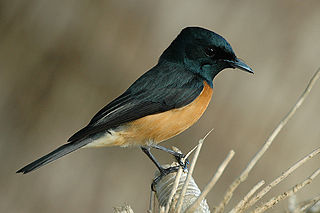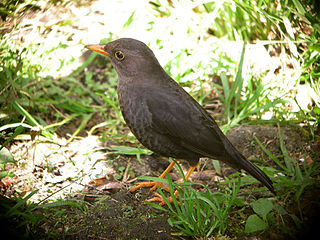
The Pacific swallow is a small passerine bird in the swallow family Hirundinidae. It breeds in tropical southern Asia and the islands of the south Pacific. It is resident apart from some local seasonal movements. This bird is associated with coasts, but is increasingly spreading to forested uplands. It was formerly treated as conspecific with hill swallow, the welcome swallow and the Tahiti swallow.

The island thrush is a common forest bird in the thrush family. Almost 50 subspecies have been described, ranging from South East Asia and Melanesia, to Samoa, exhibiting great differences in plumage. Several subspecies are threatened and three have already become extinct.

The uniform swiftlet, also known as the Vanikoro swiftlet or lowland swiftlet, is a gregarious, medium-sized swiftlet with a shallowly forked tail. The colouring is dark grey-brown, darker on the upperparts with somewhat paler underparts, especially on chin and throat. This species is widespread from the Philippines through Wallacea, New Guinea and Melanesia. It forages for flying insects primarily in lowland forests and open areas. It nests in caves where it uses its sense of echolocation, rare in birds, to navigate.

The rusty-winged starling is a species of starling in the family Sturnidae. It is found in the Santa Cruz Islands and Vanuatu.

The hooded monarch is a species of bird in the family Monarchidae. It is found on New Guinea. Its natural habitat is subtropical or tropical moist lowland forests.

The Melanesian flycatcher is a species of bird in the monarch-flycatcher family Monarchidae. The species is found on islands in Melanesia.

The Vanikoro flycatcher is a species of monarch flycatcher in the family Monarchidae. It has a slightly disjunct distribution, occurring on Vanikoro island and in Fiji.

Fiji island-thrush is a species of passerine in the family Turdidae endemic to Fiji. It was formerly considered a subspecies of Island thrush, but in 2024 the Island thrush was split into 17 different species by the IOC and Clements Checklist based on morphological and phylogenic differences.

The Samoan island-thrush is a species of passerine in the family Turdidae. It is endemic to the Samoan Islands, which includes Samoa and American Samoa. It was formerly considered a subspecies of Island thrush, but in 2024 the Island thrush was split into 17 different species by the IOC and Clements checklist based on morphological and phylogenic differences.

Luzon island-thrush is a species of passerine in the family Turdidae. It is endemic to the island of Luzon in the Philippines. It was formerly considered to be two separate subspecies of Island thrush until 2024 when it was classified as a distinct species by the IOC and Clements checklist.

Papuan island-thrush is a species of passerine in the family Turdidae. It is endemic to New Guinea and Goodenough Island in the countries of Papua New Guinea and Indonesia. It was formerly considered to be a number of subspecies of Island thrush until 2024 when it was classified as a distinct species by the IOC and Clements checklist.

The New Caledonian island-thrush, is a species of passerine in the family Turdidae. It is endemic to the island of Grande Terre in New Caledonia. It was considered to be a subspecies of Island thrush until 2024 when the Island thrush was split into 17 species by the IOC and Clements checklist.

The White-headed island-thrush, also known as the Loyalty island-thrush, is a species of passerine in the family Turdidae. It is found in Vanuatu, and New Caledonia. It was formerly considered to be a subspecies of Island thrush, but was classified as a distinct species by the IOC and Clements checklist in 2024.
The Bougainville island-thrush is a species of passerine in the family Turdidae. It is endemic to Bougainville Island in Papua New Guinea. It was formerly considered a subspecies of Island thrush, but was split by the IOC and Clements checklist in 2024.
The Bismarck island-thrush, is a species of passerine in the family Turdidae. It is endemic to islands in Papua New Guinea. It was formerly considered to be multiple subspecies of Island thrush, until 2024 when the Island thrush was split into 17 species by the IOC and Clements checklist.

The Wallacean island-thrush, also known as the Sulawesi island-thrush, is a species of passerine in the family Turdidae. It is found in Indonesia and Timor-Leste. It was formerly considered to be multiple subspecies of Island thrush, but was classified as a distinct species in 2024 by the IOC and Clements checklist based on morphological and phylogenic evidence.
The Solomons island-thrush, also known as the Guadalcanal island-thrush, is a species of passerine in the family Turdidae. It is endemic to the Solomon Islands. Prior to 2024, it was considered to be two different subspecies of Island thrush.

The Sundaic island-thrush, also known as the Sunda island-thrush, is a species of passerine in the family Turdidae. It is found in Indonesia and Malaysia. Prior to 2024, the Sundaic island-thrush was considered to be eight separate subspecies of Island thrush. It has the largest distribution in the Island thrush complex, ranging from northern Sumatra south to Java, with a disjunct population in northern Borneo.

The Mindanao island-thrush, also known as the Negros island-thrush, is a species of passerine in the family Turdidae. It is endemic to the Philippines. Prior to 2024, it was four separate subspecies of Island thrush, before the Island thrush was split into 17 species by the IOC and Clements checklist.
The Moluccan island-thrush, also known as the Sula island-thrush, is a species of passerine in the family Turdidae. It is endemic to Indonesia. Prior to 2024 it was considered to be two separate subspecies of Island thrush.
















